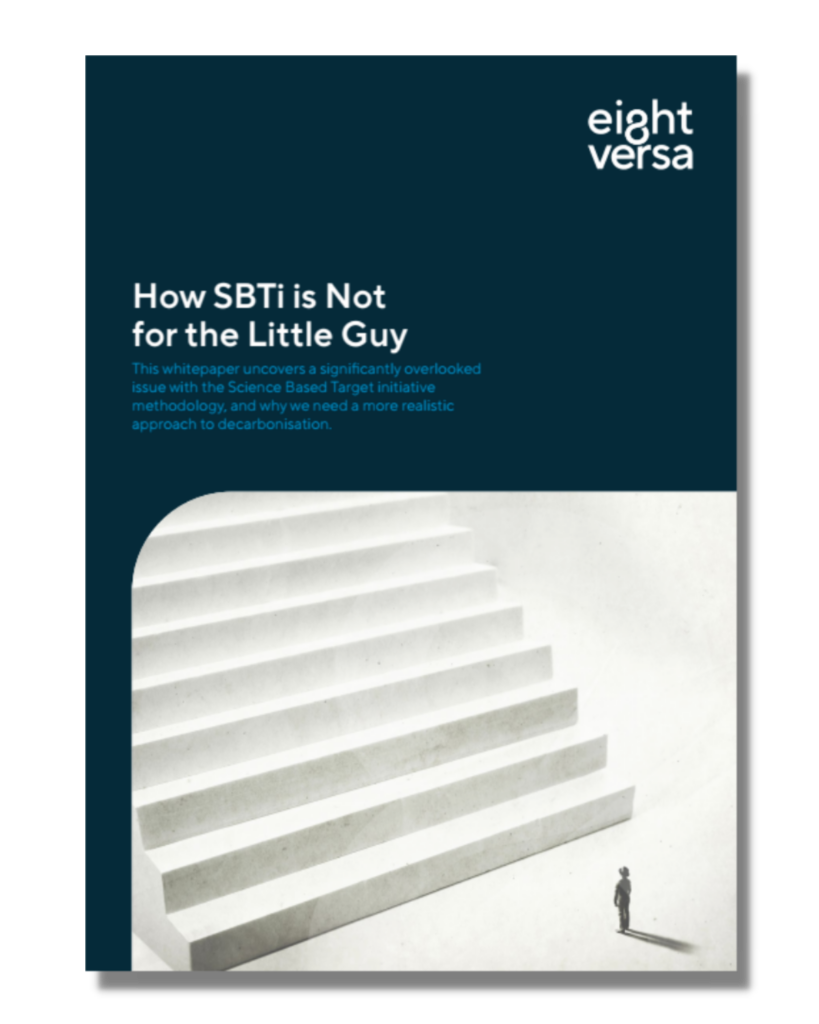Businesses are increasingly being expected to decarbonise at the same time as growing their revenues and profits. The latest framework used for this; Science Based Targets Initiative (SBTi) requires long term target setting and aggressive annual cuts in emissions. This leaves many business leaders with the choice of either achieving their business objectives or climate targets. It unlikely to be both.
Some organisations who are aspiring to reach Net Zero as soon as 2030 are suddenly realising the impossible task ahead. As the reality of this not-so-distant aspiration gets closer, these ambitious Net Zero commitments are increasingly coming under scrutiny as the necessary hard choices reveal themselves. Many organisations have set these targets within the SBTi’s framework and definition of Net Zero, and it won’t be long before many realise that it’s simply not possible under this current methodology.
That’s why we propose an alternative. One that encourages companies to grow and prioritises long term innovation.
Intensity Based
The primary flaw with the SBTi methodology is that it prioritises Absolute Contraction. This approach focuses on reducing a company’s absolute emissions year-on-year, i.e. it sets a carbon budget and then applies the long-term target of reaching a 90% reduction, in absolute terms, thus becoming a ‘Net Zero’ organisation.
Conversely, an Intensity Target takes into account a company’s specific circumstances and focuses on reducing emissions per unit of output. SBTi has recently confirmed that intensity-based reductions are an option for Scope 3 emissions, but that this is exclusive to businesses over 500 employees. This means SMEs must opt for the least flexible option and follow the Absolute Contraction approach.
Levelling the Playing Field
The “Limits to Growth” mindset appears to have been adopted by the SBTi which has not adequately considered who the big businesses of the future will be. Many organisations founded in the last 20 years have experienced huge growth in their sector and have become sector leaders. It would not have been possible for these companies to grow at the rate they did whilst aggressively decarbonising, as they would have had to impose the SBTi carbon budget which would have capped them at the footprint of a start-up. To suggest that these companies should dramatically slow their growth or cease to compete in their market is ludicrous, yet it is the SBTi definition of Net Zero. We need to find a method that levels the playing field.
The best carbon accounting method to use is one based on intensity targets, across all emission Scopes; they provide better incentives for growing companies to innovate and adopt new technologies and allow them to reduce their emissions intensity over the long term.
Achieving Net Zero based on Company Size and Growth using the SBTi methodology:

Punishing Innovation
The primary purpose of embracing a dynamic and agile market is the successful development of new innovations. Innovation and R&D is an often-overlooked aspect of decarbonisation; however, it is an essential ingredient in reaching a low carbon future. For example, a company called Oxford PV has achieved a breakthrough with perovskite technology that makes solarvoltaic panels 30% more efficient than average panels. Their innovative product could unlock enormous carbon savings and break through the payback limitations of solar in some geographies. Yet, this company would not meet the rules of SBTi’s methodology and therefore could not become a Net Zero company, a definition which is increasingly used as the de-facto metric of best practice for an organisation’s decarbonisation.
Whack-a-Mole
The SBTi’s methodology takes a very ‘steady-state’ view of a sector. A steady-state model is often used to drastically simplify reality. For example, they are already used to calculate energy consumption in buildings and are used to produce Energy Performance Certificates (EPCs). However, this wholly omits the dynamic and complex nature of an economic sector or market, and the oversimplification sacrifices the productive solutions that will enable markets to decarbonise. This strategic faux pas is showcased in other sustainability efforts such as the rejection of Heathrow’s airport expansion, which was objected to on account of it breaking the UK’s carbon budget. However, the rejection of Heathrow’s expansion will have no meaningful effect on reducing global emissions. Flight volumes will continue to increase because there are other factors driving demand, so any flights not accommodated by London runway will take off via Schiphol or Charles de Gaulle airport instead. This approach results in whack-a-mole scenario and does nothing to reduce global GHG emissions.


A Workable Solution
We can apply the logic of intensity reduction targets to the consumer goods market to see how limited Absolute Contraction can be. Around 3.2 million fridges were sold in the UK last year, and 98% of the population has a fridge. The number of fridges sold this year will be similar, so we need to consider how the sector decarbonises as a whole. From an emissions perspective, it doesn’t matter which company sells what, what matters is that the average life cycle emissions of every fridge are less in 2023 than in 2022. It’s not helpful to have a diverging market where the incumbent part of the market has the good fortune and inclination to implement SBTi targets and the other part who can’t align with carbon budgets don’t participate.
It is fairer, more coherent and better for the total sum of emissions of a market, if all players in a market are tracking down on a carbon intensity basis, thus achieving an equitable reduction from the market as a whole.
Verification and Certification
Lastly, SBTi has often been mistakenly perceived as a verification scheme. It is not and has never claimed to be. It serves as an important framework for applicable companies to align their decarbonisation pathway with every 5 years; with SBTi providing validation that there is a reduction plan in place. There is a very distinct difference between this and a ‘verification’ whereby a third-party evaluates and endorses the technical basis and veracity of company’s footprint and reduction efforts annually.
Using a verification and certification scheme, such as Natural Carbon Solutions (NCS), allows organisations to become accredited for key milestones in the process of decarbonisation. This in turn provides the necessary assurance that a company is measuring and reducing appropriately at each step, in accordance with industry best practices. Frequent, detailed measurement and verification of a carbon footprint vastly increases the likelihood of reaching the specified target and enables an informed and proactive approach to decarbonising an organisation.
The Way Forward
If we are to limit climate change to roughly 1.5 to 2°C of warming, then we need to aim for a 90% emissions reduction by 2050. This is the long-term reduction pathway we recommend to all of our clients, however, our advice is to do this on an intensity per unit of output basis. You need to show your customers that you are getting more efficient, and you need a metric that cuts through the spin and compares you fairly with your peers.
We advise our clients to always be operating with a carbon reduction plan in place, working towards your next 12 month, 2 year and 3 year emission reduction. This carbon reduction plan should build-in the inevitable ups and downs of business activity and be aligned with the company’s business plan for well-timed tactical business decisions that can deliver real reductions. Remember that carbon reduction plans are needed for credibility, but they also send market signals to suppliers encouraging them to follow suit and entrepreneurs to create new solutions for growing demands.
Embracing innovation is key to success in the long run. While pursuing longer-term reductions, there might be instances where short-term footprint expansion becomes necessary. Despite some frameworks suggesting otherwise, rest assured that making these strategic moves is the right course of action.
Find Out More
Net Zero and setting a decarbonisation pathway is a complex subject that can’t be summarised in 1,300 words, and so we have created a more extensive argument for intensity metrics in our latest whitepaper here. If you are interested in finding out more about setting realistic carbon reduction targets you can get in touch with one of our experts who would be happy to help.







